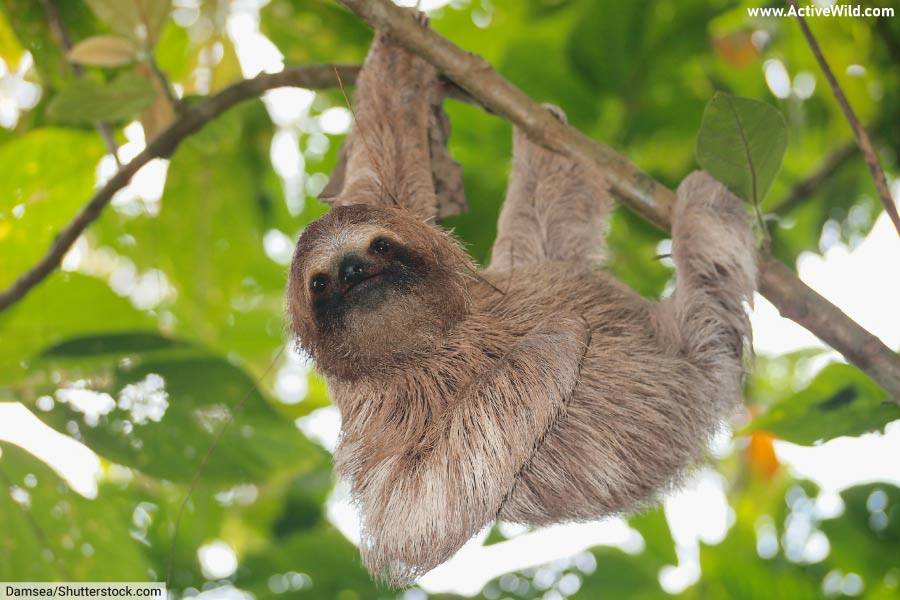
A complete guide to the different types of sloths, with pictures, species descriptions, and conservation information.
Different Types Of Sloths
There are six species of sloths; divided between two families: Bradypodidae, the three-toed sloths; and Choloepodidae, the two-toed sloths.
There are four three-toed sloth species: the brown-throated sloth, maned sloth, pale-throated sloth and pygmy three-toed sloth.
There are two two-toed sloth species: Hoffmann’s two-toed sloth and Linnaeus’s two-toed sloth.
New Sloth Species?
A seventh sloth species, the southern maned sloth (Bradypus crinitus), a species of three-toed sloth, was identified in a paper published in 2022 (link).
At the time of writing (August 2023), however, the southern maned sloth is yet to be included in either the Mammal Species of the World database (link) or the Catalogue of Life (link), both of which were consulted in the writing of this article. You can find out more about the species in the list below.
Use the index below to find information on a particular type of sloth, or continue scrolling to browse all species.
Page Index
Differences Between Three-Toed Sloths Vs Two-Toed Sloths
Sloth Species List With Pictures & Facts
- Pygmy Three-Toed Sloth
- Maned Sloth
- Pale-Throated Three-Toed Sloth
- Brown-Throated Three-Toed Sloth
- Southern Maned Sloth
- Linnaeus’s Two-Toed Sloth
- Hoffmann’s Two-Toed Sloth
Discover More With Active Wild
All About Sloths

Sloths are slow-moving mammals native to the tropical rainforests of Central and South America. These unique creatures are known for their leisurely pace, spending most of their lives hanging upside-down from tree branches.
Sloths belong to the taxonomic families Bradypodidae (three-toed sloths) and Choloepodidae (two-toed sloths), both of which are part of the order Pilosa, which is also home to anteaters – the closest relatives of sloths in the animal kingdom. The six (or seven) species of sloth make up the suborder Folivora.
These tree-dwelling, rainforest animals have a distinct appearance, with long limbs, curved claws and flat faces. Their bodies are adapted for a life spent in trees — their strong, curved claws allow them to securely grasp tree branches, and their slow metabolism helps conserve energy in their low-nutrient diet of leaves.
Sloths are solitary animals, generally coming together only for mating. Their slow movements make them vulnerable to predators, but their greenish-brown fur, which can host symbiotic algae, provides a form of camouflage, allowing them to blend in with the trees. The algae also offers sloths a supplementary source of nutrients.
Despite their seemingly laid-back demeanor, sloths play a vital role in their ecosystems. They serve as a mobile habitat for a range of insects and fungi and aid in spreading seeds through their fecal matter, promoting forest growth.
Differences Between Three-Toed Sloths Vs Two-Toed Sloths
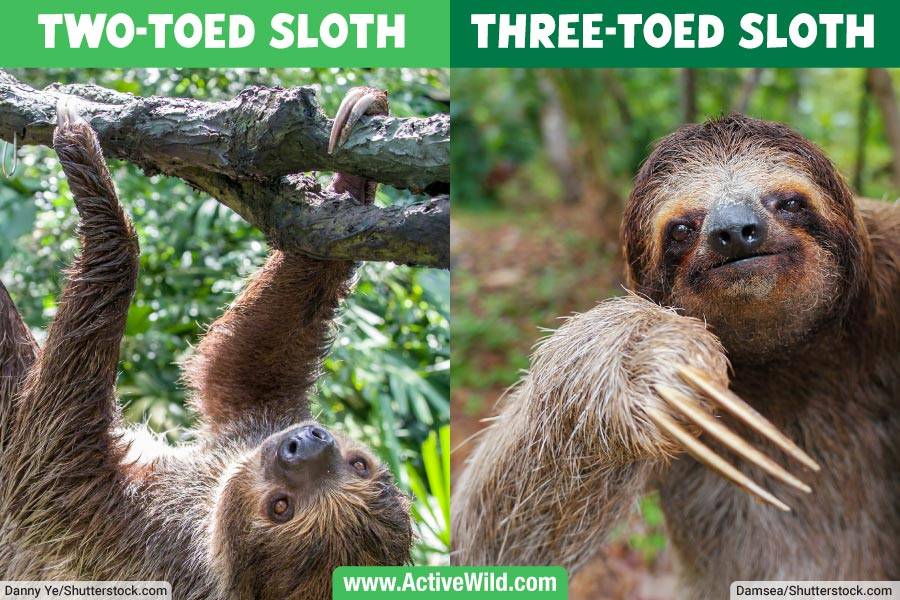
- Number of Toes: As their names suggest, three-toed sloths have three toes on their forelimbs, while two-toed sloths have only two. (All sloths have three toes on their hind limbs.)
- Families: Three-toed sloths belong to the family Bradypodidae, whereas two-toed sloths are members of the family Choloepodidae.
- Facial Features: Three-toed sloths typically have a more prominent ‘mask’ around their eyes compared to two-toed sloths.
- Diet: While both are primarily herbivores, two-toed sloths have a more varied diet, occasionally consuming insects, small reptiles, and birds. Three-toed sloths are more strictly herbivorous, primarily feeding on leaves.
- Activity Pattern: Two-toed sloths are mainly nocturnal, while three-toed sloths are mainly diurnal (active during the day), but may also be active at night.
- Size & Appearance: Three-toed sloths are generally smaller and have a more rounded head and face and longer tails. Two-toed sloths have longer hair and a more elongated face, and their fore and hind limbs are more equal in length.
- Movement: Two-toed sloths tend to move faster than three-toed sloths.
Sloth Species List With Pictures & Facts
Pygmy Three-Toed Sloth
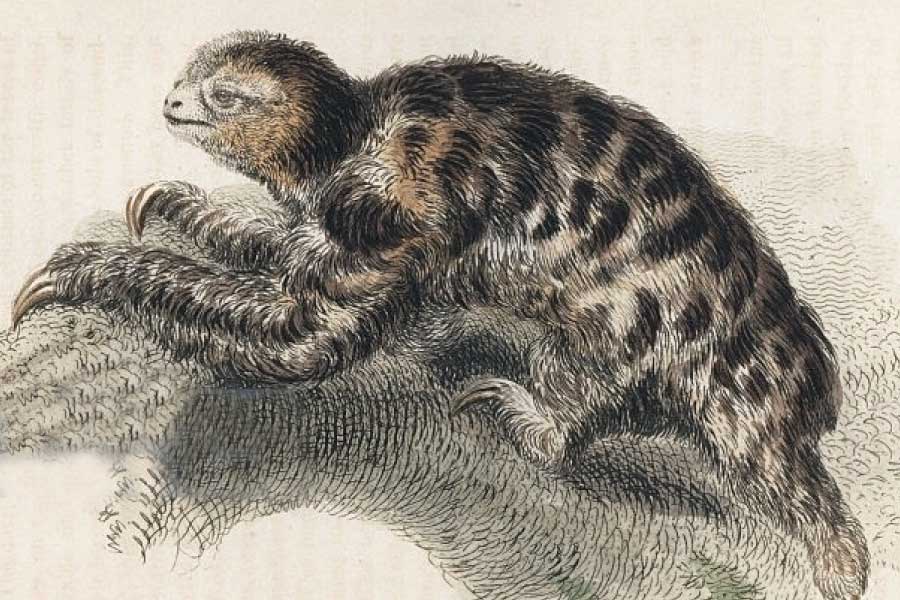
Scientific Name: Bradypus pygmaeus
Family: Bradypodidae (Three-toed sloths)
Weight: Approximately 2.5-3.5 kg (5.5-7.7 lb)
Where Found: Exclusively on the Isla Escudo de Veraguas, off the coast of Panama
IUCN Conservation Status: Critically Endangered
- Smallest sloth species.
- Exclusively found on the Isla Escudo de Veraguas.
- Fur can host symbiotic algae, providing a greenish tint for camouflage.
The pygmy three-toed sloth is the smallest sloth species. Its back is slightly spotted and (like that of other sloth species) often green in color due to algae living in its fur.
The species is found only on the Isla Escudo de Veraguas, a small island off the coast of Panama. Here it lives both in the forests of red mangrove trees and in the dense tropical rainforests of the island’s interior.
Due to its limited range, the pygmy three-toed sloth is particularly vulnerable to threats, and its population is estimated to be less than 500.
Maned Sloth
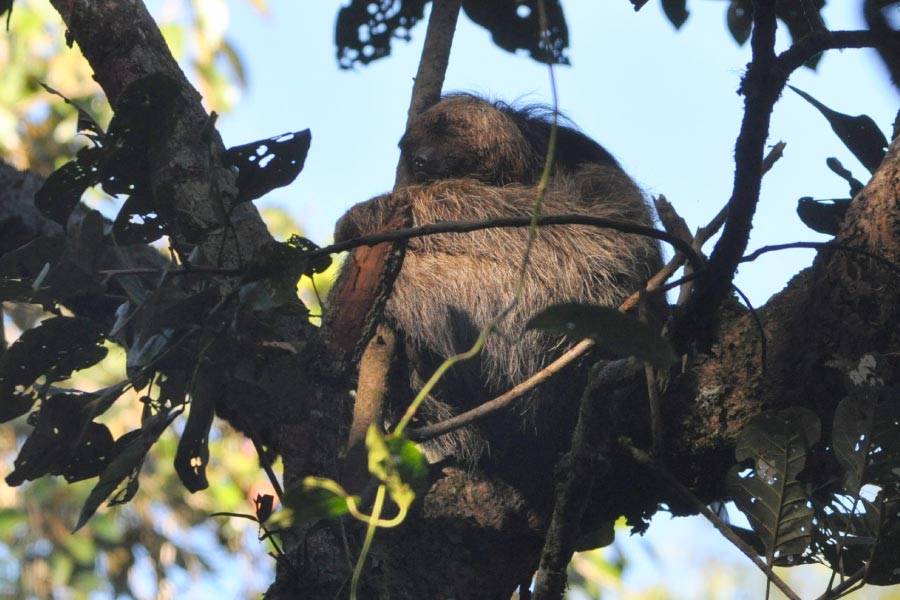
Scientific Name: Bradypus torquatus
Family: Bradypodidae (Three-toed sloths)
Weight: 4-4.5 kg (8.8-9.9 lb)
Where Found: Atlantic coastal rainforest in southeastern Brazil
IUCN Conservation Status: Vulnerable
- Prominent mane of long black hair, especially visible on the back of males.
- Found only in the Atlantic coastal rainforest of southeastern Brazil.
The Maned Sloth is a three-toed sloth found exclusively in the Atlantic coastal rainforest of southeastern Brazil. It Is present in three Brazilian states: Espírito Santo, Rio de Janeiro and Bahia.
The species is distinguished by the mane of long black hair on its neck and shoulders, which is particularly prominent in males.
The lifespan of the maned sloth is known to exceed twelve years in the wild.
Pale-Throated Sloth

Scientific Name: Bradypus tridactylus
Family: Bradypodidae (Three-toed sloths)
Weight: Approximately 3.5-4.5 kg (7.7-9.9 lb)
Where Found: Northern South America, including parts of Guyana, Brazil, and Venezuela
IUCN Conservation Status: Least Concern
- Distinct pale face and throat with a darker “mask” around the eyes.
- Primarily dwells in the upper canopy of tropical rainforests.
The pale-throated sloth is a species of three-toed sloth found in the tropical forests of northern South America. It is present in areas of Guyana, French Guiana, Suriname, Brazil, and Venezuela. It is not found south of the Amazon River.
As its name suggests, the pale-throated sloth is characterized by a pale face and throat, contrasting with a darker “mask” around its eyes. Individuals of both sexes are dark grey with darker patches; males can be identified by an orange or yellow patch on the back, which is divided by a black stripe.
Brown-Throated Sloth

Scientific Name: Bradypus variegatus
Family: Bradypodidae (Three-toed sloths)
Weight: Approximately 4-4.6 kg (8.8-10.1 lb)
Where Found: Ranges from Honduras in Central America to northern Argentina in South America
IUCN Conservation Status: Least Concern
- Recognizable brown-colored throat.
- Most widespread and adaptable of the three-toed sloths.
- Fur coloration can vary significantly based on location and age.
The brown-throated three-toed sloth is the most widespread and common species of three-toed sloth, inhabiting a range that spans from Honduras in Central America to northern Argentina in South America.
As indicated by its name, the brown-throated three-toed sloth has a brown-colored throat, with fur that can vary in shade from gray to brown based on location and age.
Although rated as ‘Least Concern’ by the IUCN, the brown-throated three-toed sloth’s population is thought to be decreasing, with threats including deforestation and hunting by local people.
Southern Maned Sloth
No image available
Scientific Name: Bradypus crinitus
Family: Bradypodidae
Weight: Approximately 4-4.5 kg (8.8-9.9 lb)
Where Found: Atlantic coastal rainforest in southeastern Brazil, particularly in the states of Espírito Santo and Rio de Janeiro.
IUCN Conservation Status: Uncategorized
- Only recently identified as a separate species to the maned sloth
- Head resembles a coconut!
The southern maned sloth was first discovered in 1850 by English zoologist John Edward Gray, although the species was not recognized by the wider scientific community, who considered it to be a maned sloth.
A recent paper (Link) *** proposes that the southern maned sloth should be treated as a separate species on the basis of DNA analysis and field observations.
The southern maned sloth has a flatter skull, more rounded jaw and wider cheekbones than its northern cousin. Its head is described as resembling a “coconut”.
The species is found in the Atlantic Forest of Brazil, and is present in the states of Espírito Santo and Rio de Janeiro.
Linnaeus’s Two-Toed Sloth
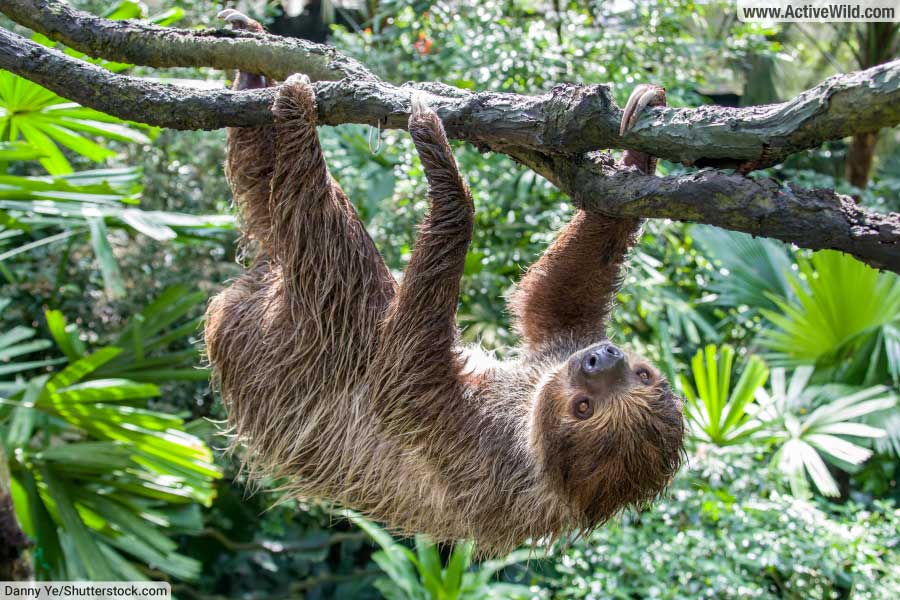
Scientific Name: Choloepus didactylus
Family: Choloepodidae (Two-toed sloths)
Weight: Approximately 4-6 kg (8.8-13.2 lb)
Where Found: Throughout the Amazon Basin in northern South America
IUCN Conservation Status: Least Concern
- Nocturnal in nature.
- More varied diet than three-toed counterparts, including fruits and occasionally small prey.
Linnaeus’ two-toed sloth is found in South American rainforests north of the Amazon River. It is also known as “Linné’s Two-toed Sloth”. The species has an elongated face and long shaggy, pale brown fur.
This nocturnal sloth species has a diet more varied than that of three-toed sloths; as well as leaves, it also eats a variety of other plant material such as shoots and fruit, and will also prey on small vertebrates.
Hoffmann’s Two-Toed Sloth
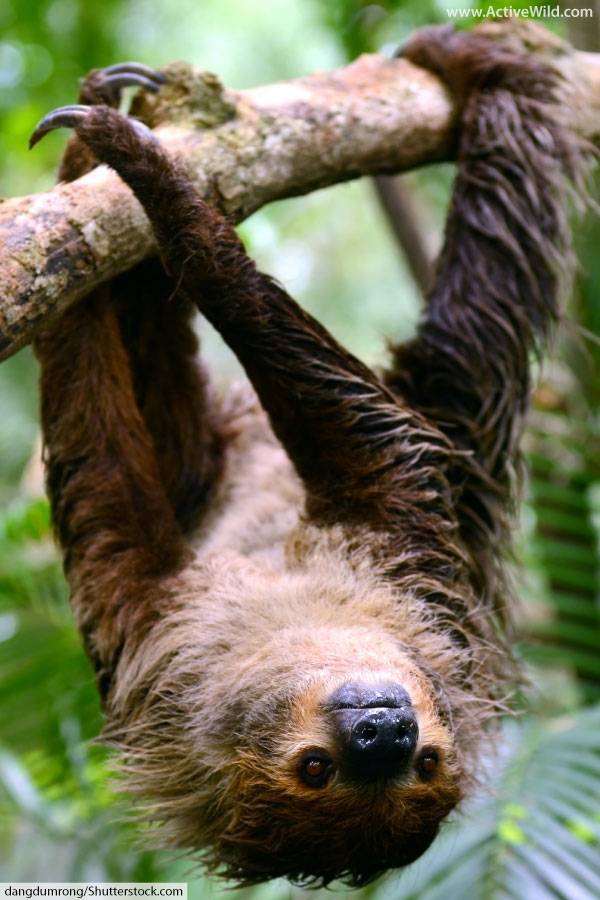
Scientific Name: Choloepus hoffmanni
Family: Choloepodidae (Two-toed sloths)
Weight: 4-5 kg (8.8-11 lb)
Where Found: Range spans from Nicaragua in Central America down to Peru and Brazil in South America
IUCN Conservation Status: Least Concern
- Similar appearance to Linnaeus’s two-toed sloth but with slight differences in distribution and habitat preferences.
- Primarily nocturnal.
- Can be found in various habitats, including rainforests, cloud forests, and mangroves.
Hoffmann’s two-toed sloth is a nocturnal sloth species found in the canopies of Central and South American rainforests. Characterized by its two claws on each forelimb, long shaggy fur, and an elongated face, this species is among the largest of the extant sloths.
Adaptable to different habitats, Hoffmann’s two-toed sloth can be found in rainforests, cloud forests, and even dry forests. Its diet is varied, including leaves, fruits, and occasionally small prey.
Discover More With Active Wild
You can find out more about sloths on this page: Sloth Facts
You can see more rainforest animals on this page: Rainforest Animals List with Pictures & Facts
You can see more South American animals on this page: South American Animals
Visit our main animals page for links to animal information and a complete guide to the animal kingdom: Animals
The post Different Types Of Sloths: Sloth Species List With Pictures & Facts appeared first on Active Wild.